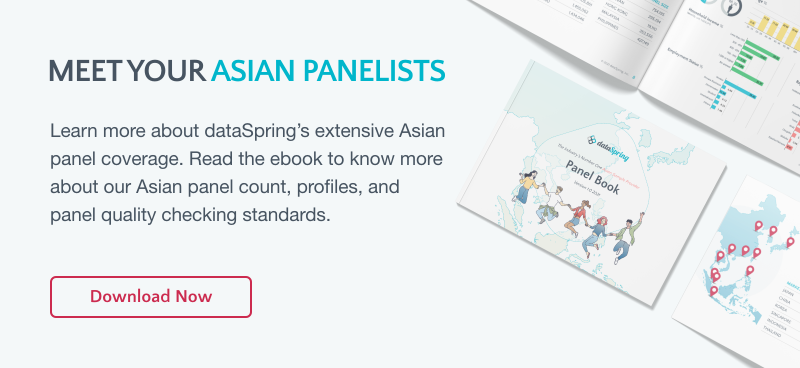 Across Asia, a new generation is shaping the future of consumption—digitally native, culturally diverse, and fiercely influential. Gen Z, born roughly between 1997 and 2012, already makes up a significant portion of the population in many Asian countries. With distinct social values, spending habits, and tech-savviness, they’re redefining consumer expectations across industries.
Across Asia, a new generation is shaping the future of consumption—digitally native, culturally diverse, and fiercely influential. Gen Z, born roughly between 1997 and 2012, already makes up a significant portion of the population in many Asian countries. With distinct social values, spending habits, and tech-savviness, they’re redefining consumer expectations across industries.
At dataSpring, we tap into the voices of over 2 million panelists across 12 Asian markets: China, Hong Kong, India, Indonesia, Japan, Malaysia, Philippines, Singapore, South Korea, Taiwan, Thailand, Vietnam.
🌏 The Rise of Gen Z Consumerism in Asia
Why Gen Z Across Asia Matters
- Gen Z, born roughly late 1990s to early 2010s, will make up around 25% of Asia’s population by 2025—and hold significant purchasing power.
- In major markets (e.g. China, India, Indonesia), Gen Z accounts for significantly larger shares of households’ total spend versus global averages.
Cross‑Country Patterns
- A joint study across China, Indonesia, Japan, South Korea, Thailand, and more (total six countries) found consistent Gen Z traits across APAC: high social media dependence, strong brand awareness, demand for personalization, video-driven discovery, and a desire for sustainable—but not overpaid—products.
- Major APAC findings: Gen Z spends up to 8.5 hours/day on phones (Indonesia highest), with over 50% influenced by online videos monthly.

Country Highlights
1. China
- Gen Z (~16% of population; ~233 million) accounted for 11–13% of national consumption in 2021, with rising usage of microcredit and installment payments.
- A growing “minimalist” trend led by so-called cleanfluencers on Douyin, Kuaishou, Bilibili: decluttering lifestyle has influenced consumption—less impulse, more purpose.
2. Hong Kong
- Gen Z makes about 11% of the population. They’ve increasingly driven value in art, luxury watches, jewelry, and collectibles, capturing ~21% of regional auction sales growth in 2022 vs ~11% in 2019.
3. India
- Though detailed studies are fewer, regional reports and broader research suggest Indian Gen Z remains optimistic, price-conscious, and digitally engaged across channels.
4.Indonesia, Thailand & Vietnam
- Southeast Asia’s Gen Z (ages ~11–26) increasingly motivates digital consumption: online grocery, e‑commerce, social media influence, heavily driven by K‑Pop trends and digital-native lifestyles.
- Particularly in Vietnam and Thailand, Gen Z values sustainability and authenticity and is more tolerant of new social values.
5. Japan
- Japan’s Gen Z (aka “Satori generation”) is ~13–14% of the population. Many are students or financially dependent—but wield substantial influence as trendsetters and “Six‑Pocket Angels” (gift‑receiving youths). They’re open to niche and luxury brands, seek discovery, and rely on peer recommendations more than tradition—and show high sustainability awareness (e.g. used clothing, eco‑labels).
6. Singapore & Taiwan
- Emerging patterns mirror regional tendencies: digital-first, socially conscious, video-led discovery, value-seeking preferences; specific national reports currently less detailed but consistent with survey frameworks.
7. Singapore & Taiwan
- Emerging patterns mirror regional tendencies: digital-first, socially conscious, video-led discovery, value-seeking preferences; specific national reports currently less detailed but consistent with survey frameworks.
8. South Korea
- Gen Z drives South Korea’s USD 17 billion annual luxury spend, embracing “flex culture” amid economic pressure: luxury purchases as short-term gratification amid instability. They demand authenticity, brand storytelling, experience-driven retail, and K-Pop–inspired product launches. Conspicuous consumption is moderating—sustainability and purpose matter.
 🔍 Shared Themes & Takeaways (Across All 12 Countries)
🔍 Shared Themes & Takeaways (Across All 12 Countries)
- Omnichannel & Mobile-first: Gen Z shops both online and offline but expects seamless, mobile-optimized customer journeys—from research to checkout across platforms. More than half also compare prices or seek discounts before buying.
- Digital Influence & Video Culture: Video-based social media (TikTok/Douyin, YouTube, local apps) are primary brand discovery engines—Gen Z trusts peer and influencer content over traditional adverts.
- Social Responsibility & Brand Values: While Gen Z across Asia favors brands with purpose, ethical practices, and environmental messaging, they aren’t always willing to pay more for sustainability—except in markets like Thailand and Vietnam where values drive more premium decisions.
- Aspirational, yet Value-driven: Younger Asians gravitate toward a mixture of popular global brands and niche, local offerings. The balance between prestige and affordability matters—and authenticity is valued over celebrity marketing.
Conclusion
Asian Gen Z across the 12 dataSpring panel countries represents a powerful, digitally native, and socially conscious force reshaping consumer markets. While shared trends emerge—digital-first behavior, video-driven discovery, brand values—each country also offers unique cultural and economic nuances. For brands looking to thrive in Asia, successful engagement requires local insights, personalization, seamless digital experiences, and authenticity backed by meaningful purpose.
Curious to learn more about Asia’s dynamic youth culture and consumer landscape? Check out our other Eye on Asia entries: How Social Media Impacts the Buying Behavior of Asian Consumers and How Shopee Became the Top eCommerce Marketplace in Southeast Asia. See you in the next one!✨


 Download Panel Book
Download Panel Book


